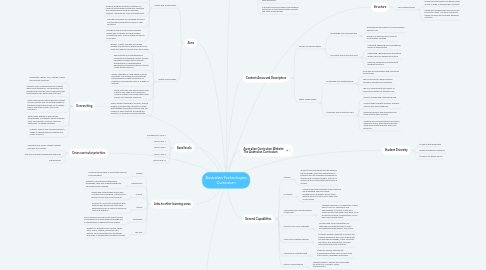
1. Overarching
1.1. Investigate, design, plan, manage, create and evaluate solutions
1.2. Students can be enterprising and creative when using traditional, contemporary and emerging technologies and understand how technologies have developed over time
1.3. Make informed and ethical decisions about the role, impact and use of technologies in the environment and society for a suitable future. how does it play a role in our economy?
1.4. Responsibly engage in appropriate technologies. Confidently select materials, data, components, systems, tools and equipment. To design solutions.
1.5. Critique, analyse and evaluate problems, needs or opportunities to identify and create solutions
2. Aims
2.1. Design and Technologies
2.1.1. Develop confidence as critical users of technologies and designers and producers of designed solutions
2.1.2. Investigate, generate and critique innovative and ethical designed solutions for sustainable futures
2.1.3. Use design and systems thinking to generate design ideas and communicate these to a range of audiences
2.1.4. Produce designed solutions suitable for a range of technologies contexts by selecting and manipulating a range of materials, systems, components, tools and equipment .
2.1.5. Evaluate processes and designed solutions and transfer knowledge and skills to new situations
2.1.6. Recognise the roles and responsibilities people who in design and technologies occupations have. How do these contribute to society?
2.2. Digital Technologies
2.2.1. Identify, create, evaluate and design suitable and innovative digital solutions to meet and redefine current and future needs
2.2.2. Demonstrate an understanding of computational thinking. identify the key concepts including data collection. interpretations, representations, algorithms and implementations used to create digital solutions.
2.2.3. Shows strengths in using digital systems efficiently. Can efficiently automate the transformation of data information to creatively communicate ideas in a range of settings
2.2.4. Apply protocols and legs practices that support safe, ethical and respectful communications and collaboration with known and unknown audiences
2.2.5. Apply systems thinking to monitor, analyse, predict and shape the interactions within and between information systems and the impact of these systems on individuals, societies, economies and environments
3. Band levels
3.1. Foundation to year 2
3.2. Years 3 and 4
3.3. Years 5 and 6
3.4. Years 7 and 8
3.5. Years 9 and 10
4. Links to other learning areas
4.1. English
4.1.1. Learning literacy skills is linked with learning in technologies
4.2. Mathematics
4.2.1. Context is used where mathematics knowledge, skills and understanding may be developed and applied.
4.3. Science
4.3.1. Design and technologies draws upon concepts from biological, chemical and physical science to solve problems
4.4. History
4.4.1. Provides an avenue to understand how technologies develop and how their developments are a source pf historical facts and artefacts
4.5. Geography
4.5.1. This curriculum provides many opportunities for students to activate their knowledge and understanding in regards to technologies.
4.6. The Arts
4.6.1. Aspects of aesthetics such as line, shape, form, colour, texture, proportion and balance are incorporated into the design processes in technologies learning activities
5. Cross curricular priorities
5.1. Aboriginal and Torres Straight Islander histories and cultures
5.2. Asia and Australias engagement with Asia
5.3. Sustainability
6. Resources
6.1. Scratch Education – Tarnica Golisano
6.2. SchoolTube – Tarnica Golisano
7. Structure
7.1. Two related strands
7.1.1. Design and Technologies knowledge and understanding - the use, development and impact of technologies and design ideas across a range of technologies contexts
7.1.2. Design and Technologies processes and production skills - the skills required to design, produce and evaluate designed solutions
8. General Capablilites
8.1. Literacy
8.1.1. Students become literate as they develop the knowledge, skills and dispositions to interpret and use language confidently for learning and communicating in and out of schools and for participating effectively in society.
8.2. Numeracy
8.2.1. Students become numerate as they develop the knowledge and skills house mathematics confidently across other learning areas at school and in their lives more broadly.
8.3. Information and Communication Technology
8.3.1. Students develop ICT capabilities as they learn to use ICT effectively and appropriately to access, create and communicate information and ideas, solve problems and work collaboratively, and in their lives beyond school.
8.4. Personal and Social capability
8.4.1. Personal and social capabilities are developed as students begin to learn and understand themselves and others.
8.5. Critical and creative thinking
8.5.1. Students develop capability in critical and creative thinking as they learn to generate and evaluate knowledge, clarify concepts and ideas, seek possibilities, consider alternatives and solve problems.
8.6. Intercultural understanding
8.6.1. Students develop intercultural understanding a they learn to value their own cultures, languages and beliefs.
8.7. Ethical Understanding
8.7.1. Students begin to identify and investigate the nature of concepts, values, characteristics.
9. Organisation
9.1. Students from Foundation to Year 8 will study two subjects: Design and Technologies and Digital Technologies
9.2. From year 9 to 10 School authorities will decide whether students can choose to continue in one or both of the above subjects.
9.3. The curriculum describes the distinct knowledge, understanding and skills of the subject and, where appropriate highlights their similarities .
9.4. In primary schools programs are designed that focus on both technologies subjects and other learning areas.
10. Content Areas and Descriptors
10.1. Design and Technologies
10.1.1. Knowledge and understanding
10.1.1.1. Development and impact of technologies in peoples lives
10.1.1.2. Design concepts across a range of technologies contexts
10.1.2. Processes and production skills
10.1.2.1. Critiquing, exploring and investigating needs or opportunities
10.1.2.2. Generating, developing and evaluating design ideas for designed solutions
10.1.2.3. Planning, producing and evaluating designed solutions
10.2. Digital Technologies
10.2.1. Knowledge and undertsanding
10.2.1.1. How data are represented and structured symbollically
10.2.1.2. The component of digital systems: Software, hardware and networks
10.2.1.3. The use, development and impact of information systems in peoples lives
10.2.2. Processes and Production skills
10.2.2.1. Collect, manage and interpreting data
10.2.2.2. Using a range of digital systems and their components and peripherals
10.2.2.3. Defining problems and specifying and implementing their solutions
10.2.2.4. Creating and communicating information, especially online, and interacting safely using appropriate technical and social protocols
